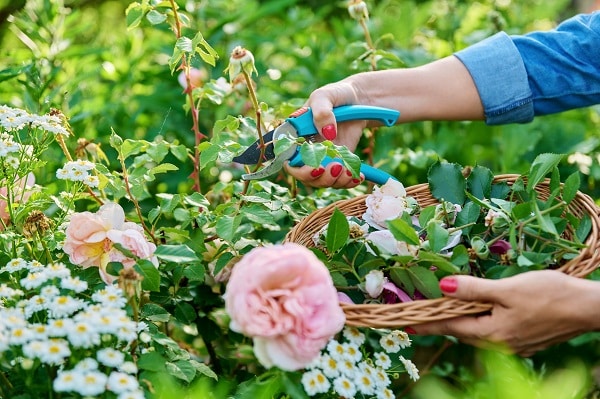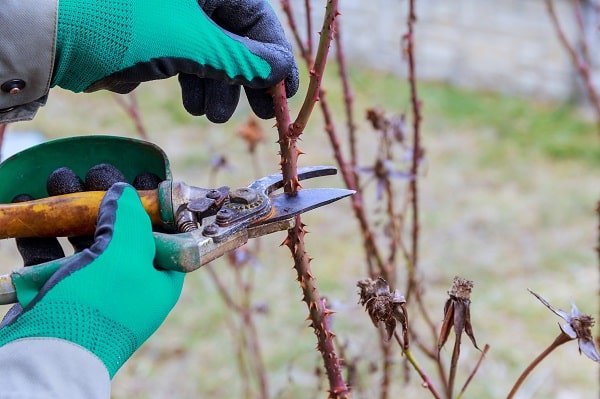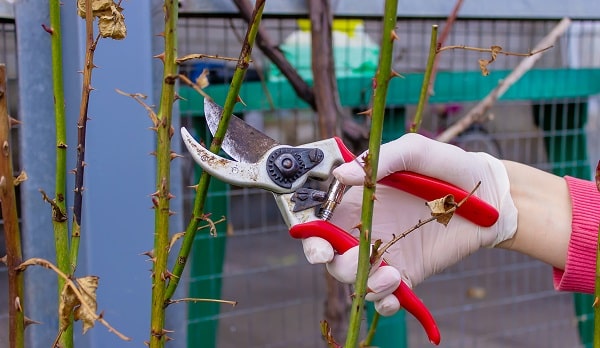Pruning your rose bush is not just a matter of aesthetics; it is crucial for the health, vigor, and productivity of your plant. This task can be intimidating for many gardeners, both novice and experienced, but understanding the why and how of pruning can transform this daunting chore into a satisfying garden activity. In this post, you will navigate through the intricacies of rose bush anatomy, explore why pruning is essential, discuss the best time for this practice, and finally delve into the necessary tools you’ll need for the job!
Contents
The Anatomy Of A Rose Bush
A rose bush isn’t just a cluster of beautiful blooms; it’s a complex structure of canes, buds, and leaves. The canes, which are the rose bush’s thick, arching stems, sprout leaves and bear the lovely roses you so admire. Buds are the small bulges that you see on the canes from which new growth – canes or blooms – springs forth. Understanding the rose bush anatomy is the first step to effective pruning. Without this knowledge, you might accidentally remove healthy, productive parts of your plant, stunting its growth and impacting the overall flower production.
To enhance your pruning skills, it is important to know that outward-facing buds are the best places to cut. When you prune just above these buds, you encourage the rose bush to grow outwards, improving its shape and providing better airflow throughout the plant. This reduced congestion also decreases the likelihood of diseases, as fungi and bacteria thrive in damp, stagnant conditions. Understanding your plant’s anatomy will ultimately allow you to prune your roses in a manner that bolsters their health and beauty.
Why Prune A Rose Bush?
Pruning a rose bush might seem counterproductive, especially when you’re cutting off growth. However, this practice actually invigorates your plant. Pruning stimulates growth by channeling the rose bush’s energy into fewer canes and buds, thereby resulting in larger, more vibrant blooms. By removing old, weak, or overcrowded wood, you’re allowing the plant to direct its nutrients and energy to new, robust growth.
Pruning your rose bush also significantly reduces the risk of plant diseases. By opening up the plant’s structure, you’re improving air circulation, which in turn decreases the humidity around the plant – a condition that many plant pathogens favor. Pruning also allows you to remove any diseased or infested parts of the plant before the problem spreads, keeping your rose bush healthy and thriving.
When To Prune Your Rose Bush
Timing is a crucial aspect of pruning your rose bush. As a general rule, you should prune just before the bush breaks dormancy after the final frost of the season. This is often in late winter or early spring. However, the exact timing can depend on your local climate and the specific variety of roses.
It’s important to note that different types of roses require different pruning schedules. For instance, hybrid tea roses, which are one of the most popular varieties, need a good pruning in early spring, while climbers do best with pruning after they’ve finished blooming. Knowing the specific needs of your rose type is key to ensuring a successful pruning experience. Always do your research before making that first cut.
Tools Needed For Pruning
When it comes to pruning your rose bush, using the correct tools can make all the difference. At the minimum, you will need a pair of bypass pruners, a pair of long-handled loppers for thicker canes, and gardening gloves to protect your hands from thorns. Bypass pruners are preferred over anvil pruners as they make clean cuts without crushing the cane, thus promoting faster healing and minimizing disease risks.
Each tool serves a unique function. Bypass pruners are used for making most of the cuts, especially on young, soft canes and stems. They function like scissors, where two blades pass by each other. On the other hand, loppers have long handles and a greater cutting force, making them ideal for cutting through old, thick canes that pruners cannot handle. Always ensure that your tools are sharp and clean. Dull tools can harm your plants by causing unnecessary injury and opening avenues for disease.
Preparation Before Pruning
Before you begin pruning your rose bush, there are several preparatory steps you need to take to ensure a smooth process. Start by clearing the area around the bush. Remove any leaves or debris to give yourself ample space to work and to prevent the accidental spread of diseases. Additionally, plan your pruning approach. Look at your rose bush and decide what you want it to look like when you’re done. This planning can guide your cuts and make the process more efficient.
Moreover, cleaning your tools before use is a critical step that shouldn’t be overlooked. Dirty tools can carry diseases from one plant to another, causing widespread damage. Simply wash them with soapy water and dry them thoroughly to avoid rust. For added protection, you can wipe your tools with a cloth soaked in rubbing alcohol to kill any lingering pathogens.
Step-By-Step Guide To Pruning
Pruning a rose bush involves several steps. The first step is removing dead, damaged, or diseased canes. These can be identified by their black, shriveled appearance. Any cane that looks unhealthy should be removed to allow room for healthy growth. Use your bypass pruners for thin canes and loppers for thicker ones. Always cut at a 45-degree angle about 1/4 inch above an outward-facing bud to encourage outward growth.
After removing unhealthy canes, your next step is to cut back healthy canes. This helps control the bush’s size and direct the plant’s energy into producing beautiful blooms. Again, make sure to cut at a 45-degree angle just above an outward-facing bud. For hybrid teas, floribundas, and grandifloras, this typically means cutting back by about one-third of the plant’s height. Lastly, shape the bush to your liking, ensuring it maintains an open center for good air circulation. Once you have finished, clean up the area and dispose of the cut canes properly to prevent the spread of diseases.
Post-Pruning Care
Once you have pruned your rose bush, it will need some extra care to recover and flourish. Start by watering it thoroughly, as pruning can be a stressful event for the plant. Water at the base of the plant to avoid wetting the foliage, which can lead to fungal diseases. Continue to water regularly, especially if there’s little rainfall.
Next, apply a balanced rose fertilizer to provide the necessary nutrients for the bush to produce new growth. Always follow the instructions on the fertilizer package to avoid over-fertilization, which can harm your plant. Lastly, keep an eye on your pruned rose bush for any signs of disease or pest infestation. Prompt action can save your rose bush from significant damage. With proper post-pruning care, your rose bush will be well on its way to producing an impressive display of blooms in the coming season.
Common Pruning Mistakes To Avoid
As with any gardening activity, there are common mistakes that people make when pruning rose bushes. One of the most common errors is over-pruning. While it’s important to cut back your rose bush to promote healthier growth, removing too much can harm your plant. Over-pruning can stress the bush, making it vulnerable to diseases and pests. Ideally, you should aim to remove about one-third of the plant during each pruning session.
Another common mistake is making cuts at incorrect angles or in the wrong places. Always aim to cut at a 45-degree angle and about 1/4 inch above an outward-facing bud. Cutting too close to the bud can harm it, and cutting too far away leaves a stub that can die back and cause problems for the plant. Also, avoid making horizontal cuts, as water can collect on the cut surface, leading to decay and disease. Correct pruning cuts heal faster and are less likely to lead to disease or pest problems.
You’re Ready To Start Pruning Your Rose Bush!
Pruning your rose bush is a rewarding task that significantly contributes to the health and aesthetic appeal of your plant. Understanding the importance of this process, being equipped with the right tools, and following the appropriate steps can make the difference between a struggling bush and one that is thriving with vibrant, abundant blooms. Always remember to prune at the right time, avoid common mistakes, and give your pruned bush the care it needs. With these insights in mind, you are now ready to embark on your rose-pruning journey with confidence and anticipation for a splendid bloom season!







